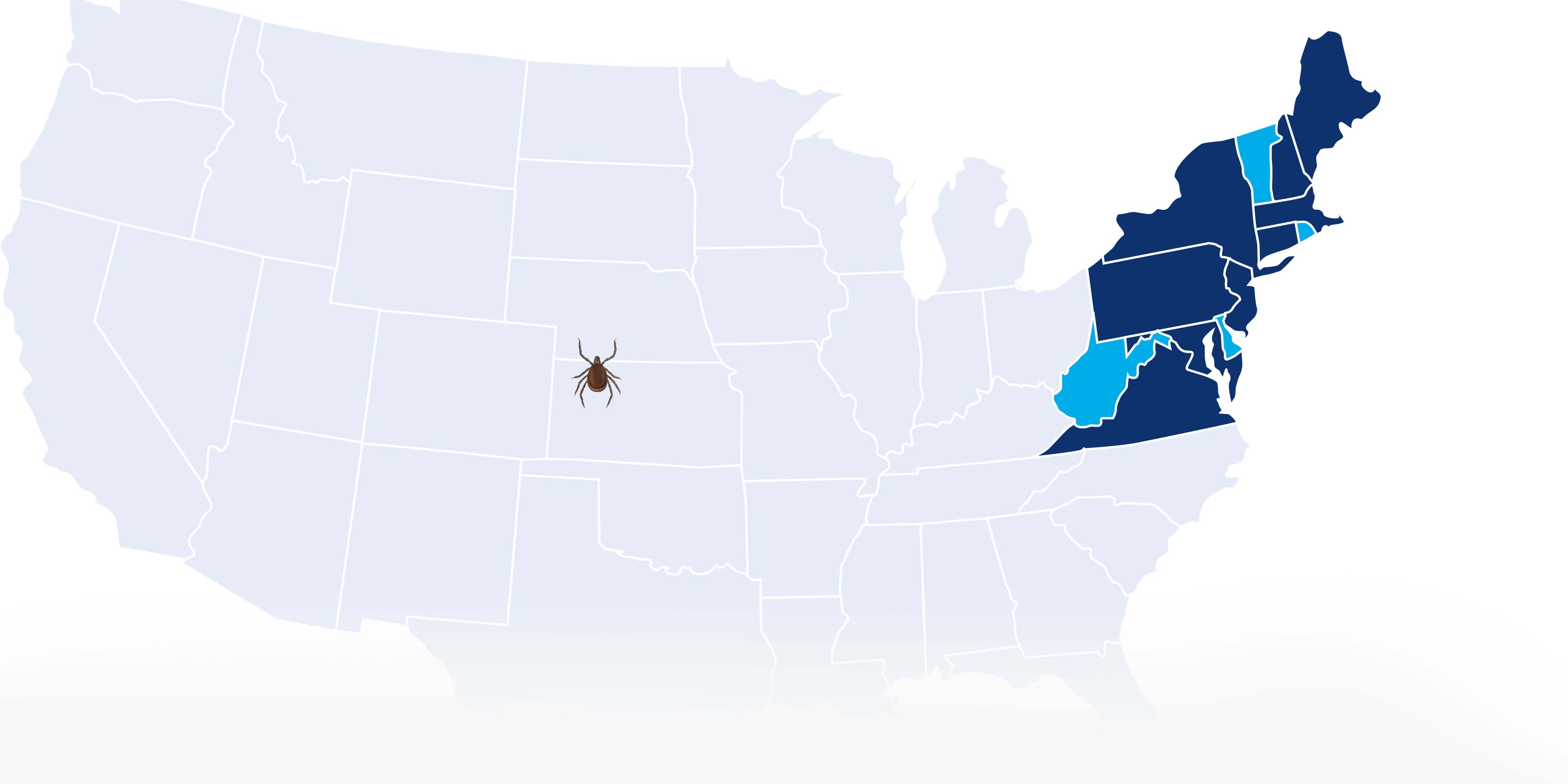Stay Informed,
Stay Healthy 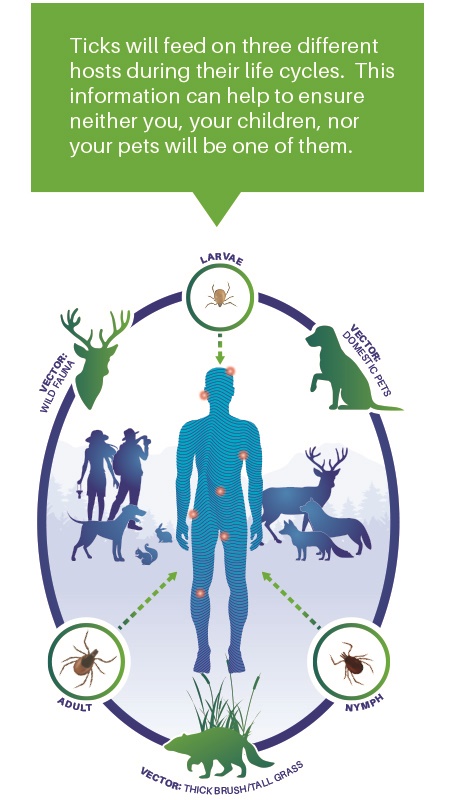
The Northeastern United States is a region with many lush wooded areas, featuring a typically cool climate that makes for delightful spring and summer weather. Such an environment is also ideal for ticks to thrive.
In fact, the area of infection for Lyme disease and other tickborne diseases has more than doubled in size across the Northeast over the past fifteen years as a result of warmer winters and continued parasitizing cycles.4 5 As such, most states in the Northeast are geographically endemic regions for tickborne diseases. Estimated cases of Lyme disease alone are more than 300,000 per year, 95% of which come from the Northeast.2
Knowing which ticks are active in your area and which diseases they carry are crucial to preventing the spread of tickborne disease.
Lone Star Tick
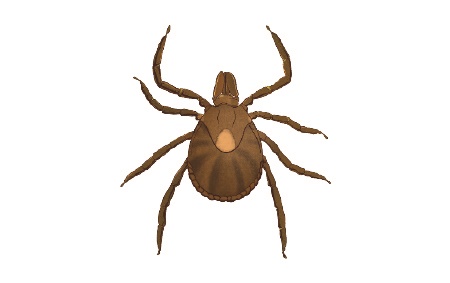
Also known as Amblyomma americanum, this species is named for the distinctive white dot on the back of the adult female. They are responsible for spreading STARI, Ehrlichiosis, Tularemia, and Heartland virus. The lone star tick was previously unique to the Southeastern United States, but has recently been found as far north as Maine.2 5 They are an aggressive species, most likely to bite humans between spring and fall, when they are coming into their nymph or adult stages.2 4
Dog Tick
Rhipicephalus sanguineus and Dermacentor variabilis – more commonly referred to as the brown dog tick and the American dog tick, respectively – are primarily responsible for 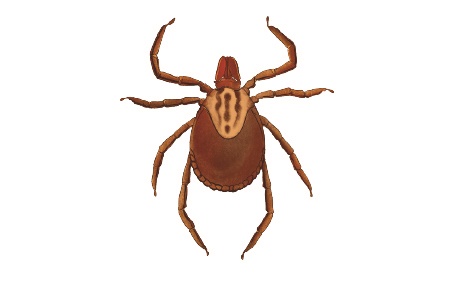 transmitting Rocky Mountain Spotted Fever. As their name suggests, these species of ticks may most commonly be found attached to dogs, which means that pet owners are at particular risk for exposure. Both species of dog tick are most likely to bite humans in the spring and summer, when they are adults.2 4
transmitting Rocky Mountain Spotted Fever. As their name suggests, these species of ticks may most commonly be found attached to dogs, which means that pet owners are at particular risk for exposure. Both species of dog tick are most likely to bite humans in the spring and summer, when they are adults.2 4
Deer Tick
The deer tick, also known as the ixodes scapularis, or the blacklegged tick, is the de facto usual 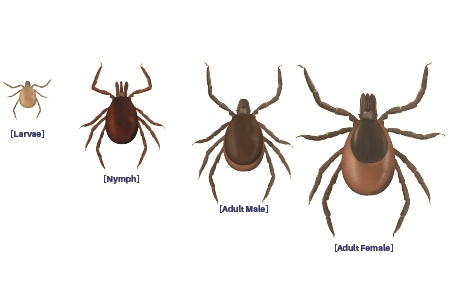 suspect for transmission of Lyme disease. Deer ticks also transmit other common tickborne diseases such as Babesiosis, Anaplasmosis and Ehrlichiosis, as well as the relatively uncommon Powassan virus disease. The deer tick is most active in spring and summer, when they’re coming into the newest stage of their life cycle. Nymphs are about the size of a poppy seed. However, fully developed adult ticks – the size of a sesame seed – are also likely to bite humans, feeding actively into the fall months.2 4
suspect for transmission of Lyme disease. Deer ticks also transmit other common tickborne diseases such as Babesiosis, Anaplasmosis and Ehrlichiosis, as well as the relatively uncommon Powassan virus disease. The deer tick is most active in spring and summer, when they’re coming into the newest stage of their life cycle. Nymphs are about the size of a poppy seed. However, fully developed adult ticks – the size of a sesame seed – are also likely to bite humans, feeding actively into the fall months.2 4
References:
1. US Department of Health and Human Services Tick-Born Disease Working Group Report to Congress, 2018. https://www.hhs.gov/sites/default/files/tbdwg-report-to-congress-2018.pdf. Accessed February 19, 2020.
2. Center for Disease Control and Prevention Tickborne Disease website. https://www.cdc.gov/ticks/tickbornediseases/index.html. Accessed February 19, 2020.
3. Guidi AJ and Sauder K. Laboratory testing for suspected acute tick-borne infections. College of American Pathologists Member Resources. 2019 Aug: 1-8
4. Fallon D and Tokarz R. A guide to ticks: three species found in the northeast. https://healthmatters.nyp.org/guide-to-three-common-ticks-in-northeast/. Accessed February 19, 2020.
5. Somer L, Buchele M, Samuel M, Wight P, Sakas ME, Mayer A, and Herz N. How warming winters are affecting everything. https://www.npr.org/2020/02/18/803125282/how-warming-winters-are-affecting-everything. Accessed February 19, 2020.

